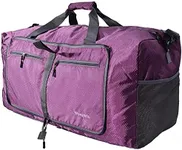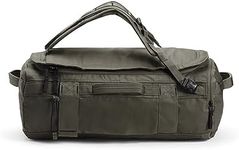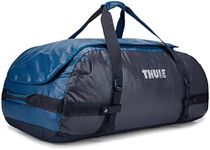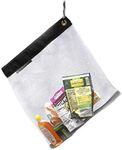Buying Guide for the Best Camp Duffel Bags
Choosing the right camp duffel bag can make your outdoor adventures more enjoyable and hassle-free. A good duffel bag should be durable, spacious, and easy to carry. When selecting a camp duffel bag, consider the following key specifications to ensure you pick the best fit for your needs.CapacityCapacity refers to the amount of space inside the duffel bag, usually measured in liters. This spec is important because it determines how much gear you can carry. Smaller bags (30-50 liters) are suitable for short trips or minimal gear, medium bags (50-70 liters) are ideal for weekend trips, and larger bags (70+ liters) are best for extended trips or when you need to carry a lot of equipment. Choose a capacity based on the length of your trips and the amount of gear you typically bring.
MaterialThe material of the duffel bag affects its durability, weight, and water resistance. Common materials include nylon, polyester, and canvas. Nylon and polyester are lightweight and often treated to be water-resistant, making them good for wet conditions. Canvas is heavier but very durable. If you expect rough use or exposure to the elements, opt for a bag made from tough, water-resistant materials.
Carrying OptionsCarrying options refer to the different ways you can transport the duffel bag. Most duffel bags have handles and shoulder straps, but some also come with backpack straps. Handles are good for short distances, shoulder straps are useful for moderate distances, and backpack straps are ideal for longer treks. Consider how far and how often you'll be carrying the bag to choose the most comfortable option for you.
WeightThe weight of the duffel bag itself is important, especially if you need to carry it for long distances. Lighter bags are easier to carry but may be less durable, while heavier bags are more robust but can add to your load. Balance the need for durability with the need for a lightweight bag based on your typical usage.
Compartments and OrganizationCompartments and organization features help you keep your gear sorted and easily accessible. Some duffel bags have multiple pockets, internal dividers, and external attachment points. If you like to keep your gear organized, look for a bag with plenty of compartments. If you prefer a simpler design, a bag with fewer pockets may be sufficient.
Water ResistanceWater resistance is crucial if you expect to encounter wet conditions. Some duffel bags are made from water-resistant materials or have waterproof coatings, while others come with rain covers. If you plan to be in rainy or wet environments, choose a bag with good water resistance to protect your gear.
DurabilityDurability refers to how well the duffel bag can withstand wear and tear. This is influenced by the material, construction quality, and reinforcements like double stitching or reinforced corners. If you expect to use the bag frequently or in rugged conditions, prioritize durability to ensure it lasts longer.
AccessibilityAccessibility is about how easy it is to get to your gear inside the duffel bag. Bags with wide openings, U-shaped zippers, or multiple access points make it easier to find and retrieve items. If you need quick access to your gear, look for a bag with good accessibility features.




















